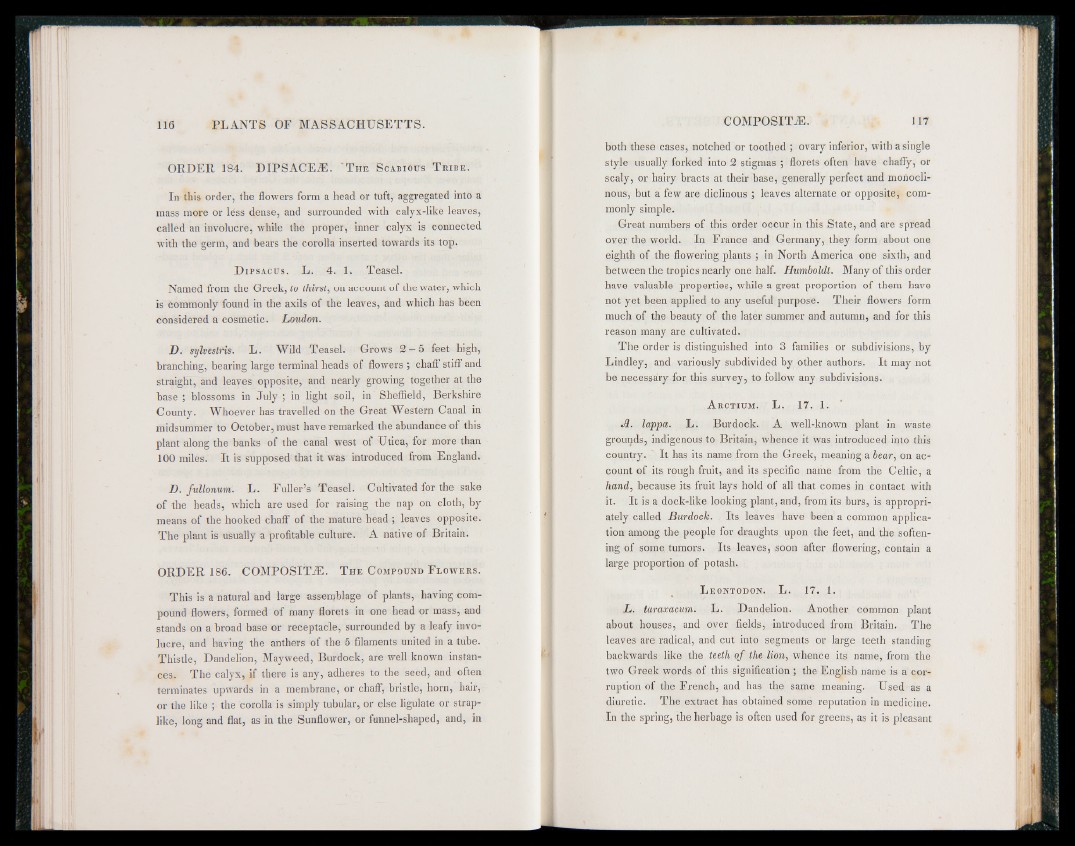
ORDER 184. D IP SA C E iE . ' T he S cabious T ribe.
In this order, the flowers form a head or tuft, aggregated into a
mass more or ldss dense, and surrounded with calyx-like leaves,
called an involucre, while the proper, inner calyx is connected
with the germ, and bears the corolla inserted towards its top.
D ipsacus. L. 4. 1. Teasel.
Named from the Greek, to thirst, on account of the water, which
is Commonly found in the axils of the leaves, and which has been
considered a cosmetic. Loudon.
D. sylvestris. L. Wild Teasel. Grows 2 — 5 feet high,
branching, bearing large terminal heads of flowers ; chaff stiff and
straight, and leaves opposite, and nearly growing together at the
base ; blossoms in July ; in light soil, in Sheffield, Berkshire
County. Whoever has travelled on the Great Western Canal in
midsummer to October, must have remarked the abundance of this
plant along the banks of the canal west of Utica, for more than
100 miles. It is supposed that it was introduced from England.
D. fullonum. L. Fuller’s Teasel. Cultivated for the sake
of the heads, which are used for raising the nap on cloth, by
means of the hooked chaff of the mature head ; leaves opposite.
The plant is usually a profitable culture. A native of Britain.
ORDER 186. C OM PO S IT E . T he C ompound F lowers.
This is a natural and large assemblage oF plants, having compound
flowers, formed of many florets in one head or mass, and
stands on a broad base or receptacle, surrounded by a leafy involucre,
and having the anthers of the 5 filaments united in a tube.
Thistle, Dandelion, Mayweed, Burdock, are well known instances.
The calyx, if there is any, adheres to the seed, and often
terminates upwards in a membrane, or chaff, bristle, horn, hair,
or the like ; the corolla is simply tubular, or else ligulate or straplike,
long and flat, as in the Sunflower, or funnel-shaped, and, in
both these cases, notched or toothed ; ovary inferior, with a single
style usually forked into 2 stigmas ; florets often have chaffy, or
scaly, or hairy bracts at their base, generally perfect and monocli-
nous, but a few are diclinous ; leaves alternate or opposite, commonly
simple.
Great number^ of this order occur in this State, and are spread
over the world. In France and Germany, they form about one
eighth of the flowering plants ; in North America one sixth, and
between the tropics nearly one half. Humboldt. Many of this order
have valuable properties, while a great proportion of them have
not yet been applied to any useful purpose. Their flowers form
much of the beauty of the later summer and autumn, and for this
reason many are cultivated.
The order is distinguished into 3 families or subdivisions, by
Lindley, and variously subdivided by other authors. It may not
be necessary for this survey, to follow any subdivisions.
A rctium. L. 17. 1.
A. lappa. L. Burdock. A well-known plant in waste
grounds, indigenous to Britain, whence it was introduced into this
country. ' It has its name from the Greek, meaning a bear, on account
of its rough fruit, and its specific name from the Celtic, a
hand, because its fruit lays hold of all that comes in contact with
it. It is a dock-like looking plant, and, from its burs, is appropriately
called Burdock. Its leaves have been a common application
among the people for draughts upon the feet, and the softening
of some, tumors. Its leaves, soon after flowering, contain a
large proportion of potash.
L eontodon. L. 17. 1.
L. taraxacum. L. Dandelion. Another common plant
about houses, and over fields, introduced from Britain. The
leaves are radical, and cut into segments or large teeth standing
backwards like the teeth of the lion, whence its name, from the
two Greek words of this signification ; the English name is a corruption
of the French, and has the same meaning. Used as a
diuretic. The extract has obtained some reputation in medicine.
In the spring, the herbage is often used for greens, as it is pleasant